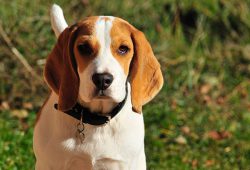The Beagle is a breed of small hound, similar in appearance to the much larger foxhound. The beagle is a scent hound, developed primarily for hunting hare. With a great sense of smell and superior tracking instinct, the beagle is employed as detection dog for prohibited agricultural imports and foodstuffs in quarantine around the world. The beagle is intelligent but single-minded. It is a popular pet due to its size, good temper, and lack of inherited health problems.
Although beagle-type dogs have existed for 2,500 years, the modern breed was developed in [wiki title=”Great_Britain” base=”EN”]Great Britain[/wiki] around the 1830s from several breeds, including the Talbot Hound, the North Country Beagle, the Southern Hound, and possibly the Harrier.
Beagles have been depicted in popular culture since [wiki title=”Elizabethan_era” base=”EN”]Elizabethan[/wiki] times in literature and paintings, and more recently in film, television, and comic books. Snoopy of the comic strip Peanuts has been called “the world’s most famous beagle”.
Appearance
The general appearance of the beagle resembles a miniature Foxhound, but the head is broader and the muzzle shorter, the expression completely different and the legs shorter in proportion to the body. They are generally between 13 and 16 inches (33 and 41 cm) high at the withers and weigh between 18 and 35 lb (8.2 and 15.9 kg), with females being slightly smaller than males on average.
They have a smooth, somewhat domed [wiki title=”Skull” base=”EN”]skull[/wiki] with a medium-length, square-cut muzzle and a black (or occasionally liver) gumdrop nose. The jaw is strong and the teeth scissor together with the upper teeth fitting perfectly over the lower teeth and both sets aligned square to the jaw. The eyes are large, hazel or brown, with a mild hound-like pleading look. The large ears are long, soft and low-set, turning towards the cheeks slightly and rounded at the tips. Beagles have a strong, medium-length neck (which is long enough for them to easily bend to the ground to pick up a scent), with little folding in the skin but some evidence of a dewlap; a broad chest narrowing to a tapered abdomen and waist and a long, slightly curved tail (known as the “stern”) tipped with white. The white tip, known as the flag has been selectively bred for, as it allows the dog to be easily seen when its head is down following a scent. The tail does not curl over the back, but is held upright when the dog is active. The beagle has a muscular body and a medium-length, smooth, hard coat. The front legs are straight and carried under the body while the rear legs are muscular and well bent at the [wiki title=”Stifle_joint” base=”EN”]stifles[/wiki].
Sense of smell
Alongside the Bloodhound and Basset Hound, the beagle has one of the best developed senses of smell of any dog. In the 1950s, John Paul Scott and John Fuller began a 13-year study of canine behavior. As part of this research, they tested the scenting abilities of various breeds by putting a mouse in a one-acre field and timing how long it took the dogs to find it. The beagles found it in less than a minute, while Fox Terriers took 15 minutes and Scottish Terriers failed to find it at all. Beagles are better at ground-scenting (following a trail on the ground) than they are at air-scenting, and for this reason they have been excluded from most mountain rescue teams in favor of collies, which use sight in addition to air-scenting and are more biddable. The long ears and large lips of the beagle probably assist in trapping the scents close to the nose.
Temperament
The beagle has an even temper and gentle disposition. Described in several breed standards as “merry”, they are amiable and typically neither aggressive nor timid, although this depends on the individual. They enjoy company, and although they may initially be standoffish with strangers, they are easily won over. They make poor guard dogs for this reason, although their tendency to bark or howl when confronted with the unfamiliar makes them good watch dogs. In a 1985 study conducted by Ben and Lynette Hart, the beagle was given the highest excitability rating, along with the Yorkshire Terrier, Cairn Terrier, Miniature Schnauzer, West Highland White Terrier, and Fox Terrier.
Beagles are intelligent but, as a result of being bred for the long chase, are single-minded and determined, which can make them hard to train. They can be difficult to recall once they have picked up a scent, and are easily distracted by smells around them. They do not generally feature in obedience trials; while they are alert, respond well to food-reward training, and are eager to please, they are easily bored or distracted.
Health
The typical longevity of beagles is 12–15 years, which is a common lifespan for dogs of their size.
Beagles may be prone to [wiki title=”Epilepsy” base=”EN”]epilepsy[/wiki], but this can often be controlled with medication. [wiki base=”EN”]Hypothyroidism[/wiki] and a number of types of [wiki title=”Dwarfism” base=”EN”]dwarfism[/wiki] occur in beagles. Two conditions in particular are unique to the breed: “Funny Puppy”, in which the puppy is slow to develop and eventually develops weak legs, a crooked back and although normally healthy, is prone to a range of illnesses; Hip dysplasia, common in Harriers and in some larger breeds, is rarely considered a problem in beagles. Beagles are considered a [wiki title=”Chondrodystrophy” base=”EN”]chondrodystrophic[/wiki] breed, meaning that they are prone to types of disk diseases.
Beagle. (2017, June 17). In Wikipedia, The Free Encyclopedia. Retrieved from https://en.wikipedia.org/w/index.php?title=Beagle&oldid=786095772


